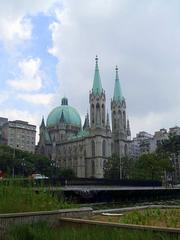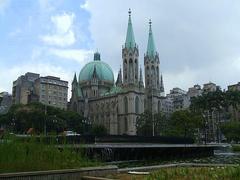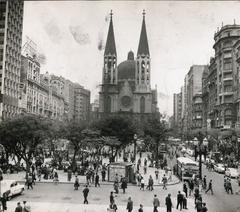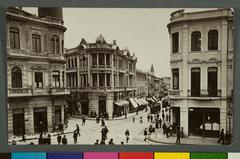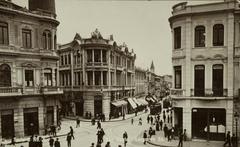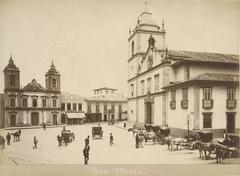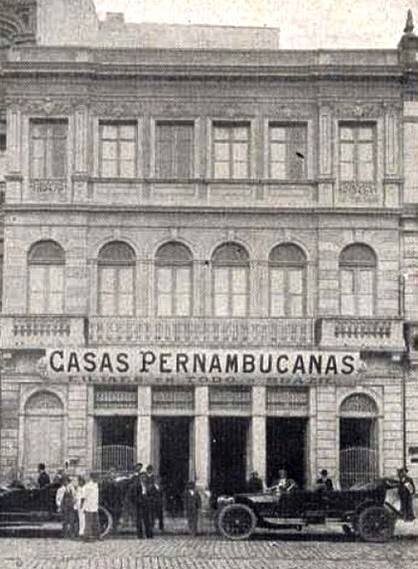
Visiting Praça da Sé, São Paulo: Tickets, Hours, and Insider Tips
Date: 14/06/2025
Introduction: The Heart of São Paulo
Praça da Sé is the geographic and symbolic center of São Paulo—a place where the city’s layered history, architectural grandeur, and multicultural vibrancy converge. Established during the colonial era as “Largo da Sé,” the square has evolved alongside São Paulo, from humble beginnings to a sprawling metropolis. The centerpiece, the Catedral Metropolitana de São Paulo (São Paulo Cathedral), is a landmark of neo-Gothic architecture, surrounded by monuments like the Marco Zero (Zero Milestone) and the statue of José de Anchieta. Praça da Sé is not only a site of religious significance but also a venue for political, civic, and cultural events, making it an essential stop for anyone seeking to understand São Paulo’s unique spirit (Cultura Genial, sao-paulo.com, Wikipedia).
Contents
- Origins and Historical Development
- Architectural and Civic Significance
- Monuments and Artistic Heritage
- Social Dynamics and Urban Challenges
- Visiting Information
- Hours and Admission
- Accessibility
- Directions
- Safety Tips
- Nearby Attractions
- FAQs
- Visuals and Media
- Conclusion
Origins and Historical Development
Praça da Sé’s story begins in the 16th century with the construction of the first Igreja Matriz (mother church), built on land donated by Cacique Tibiriçá, an indigenous leader integral to São Paulo’s founding (Cultura Genial, South America CL). By 1745, the church became a cathedral, reflecting the city’s growing importance. Urbanization accelerated in the 19th century, fueled by the coffee trade and waves of immigrants, transforming the area from a simple churchyard into a bustling civic hub (Speaking Brazilian). Major urban renewal in the early 20th century saw the demolition of older structures, making way for the modern square and setting the stage for the construction of the current cathedral (Wikipedia).
Architectural and Civic Significance
São Paulo Cathedral (Catedral da Sé)
The cathedral, designed by German architect Maximilian Emil Hehl, is a monumental neo-Gothic structure whose construction spanned from 1913 to 1954, with its towers completed in 1969 (Cultura Genial, South America CL). Its dimensions—111 meters long, 46 meters wide, and towers reaching 92 meters—make it one of the largest neo-Gothic churches worldwide. The cathedral is distinguished not only by its European style but also by Brazilian motifs, such as column capitals carved with armadillos, passion fruit, and jabuticaba. The crypt beneath the main altar houses the remains of historical figures, including Cacique Tibiriçá.
Civic Center
Praça da Sé houses the Marco Zero, the city’s official center point for measuring distances, and serves as a gathering spot for rallies, celebrations, and important historical events such as the Diretas Já movement in the 1980s (Wikipedia, Academia.edu).
Monuments and Artistic Heritage
The square is adorned with significant monuments:
- Marco Zero: Marks São Paulo’s geographic center (Wikipedia).
- Statue of José de Anchieta: Honors the Jesuit missionary and co-founder of the city.
- Modernist Sculptures: Abstract works like “Condor” and “Diálogo,” added during the 2006 renovation, enhance the square’s contemporary atmosphere.
- Monument to Saint Paul: Added in 2009, celebrating the city’s namesake.
The 1970s redesign by architect José Eduardo de Assis Lefèvre, inspired by Lawrence Halprin, introduced geometric paving, water features, and open spaces encouraging social interaction (Wikipedia).
Social Dynamics and Urban Challenges
Praça da Sé mirrors São Paulo’s diversity and complexity. It is frequented by commuters, tourists, street vendors, and a sizable homeless population. While it remains a vibrant public space and site of civic engagement, the area also grapples with urban challenges such as inequality and safety concerns (South America CL, Sacred Travel Destinations). Revitalization efforts—including improved lighting, expanded patrols, and public art—aim to preserve its accessibility while addressing social issues (sao-paulo.com, sacavoyage.fr).
Visiting Information
Hours and Admission
- Praça da Sé: Open 24/7.
- São Paulo Cathedral: Typically open from 7:00 AM to 7:00 PM daily. Hours may vary on holidays or for special events (Catedral da Sé).
- Admission: Entry to both the square and cathedral is free. The crypt and some guided tours may require a small fee or donation.
Accessibility
Both the square and cathedral are wheelchair accessible, with ramps and adapted restrooms. The Sé Metro Station is fully accessible and connects to Lines 1 (Blue) and 3 (Red) (Pordentro dos Parques).
Directions
Praça da Sé is centrally located in downtown São Paulo. The easiest access is via the Sé Metro Station. Numerous bus lines also stop nearby, and taxis or ride-hailing services are readily available (South America Travel, Expatriate Consultancy). For those traveling from the airport, a transfer or metro connection is recommended.
Safety Tips
- Remain attentive to personal belongings and avoid displaying valuables.
- Prefer visiting during daylight hours, especially if unfamiliar with the area.
- Use trusted transportation methods at night (The Broke Backpacker, Travel Safe Abroad).
Nearby Attractions
- Pátio do Colégio: Founding site of São Paulo.
- Municipal Market: Renowned for food stalls and local specialties.
- São Bento Monastery: Known for Gregorian chants and baroque interiors.
- Rua 25 de Março: Lively shopping district.
- Theatro Municipal: Historic opera house.
- Edifício Martinelli and Edifício Copan: Architectural landmarks.
- Museu da Cidade de São Paulo and Caixa Cultural: Museums with exhibitions on city history and culture (Wanderlog, Lonely Planet).
Frequently Asked Questions (FAQs)
Q: What are the opening hours for Praça da Sé and the cathedral?
A: The square is open 24/7. The cathedral usually operates from 7:00 AM to 7:00 PM, but check for updates during holidays or special events.
Q: Is there an entry fee?
A: No. Access is free; donations are welcome. Fees may apply for guided tours or crypt entry.
Q: Are guided tours available?
A: Yes, available in multiple languages. Booking in advance is recommended for groups.
Q: Is the area safe for tourists?
A: Generally safe during daylight with police presence, but vigilance is advised, especially at night.
Q: How do I get there using public transportation?
A: Take the Metro to Sé Station (Lines 1 and 3). Buses, taxis, and ride-hailing services are also options.
Visuals and Media
- Photo Opportunities: The cathedral’s façade, stained glass, the crypt, Marco Zero, and surrounding modernist landscaping.
- Virtual Tours and Interactive Maps: Available on official tourism and cathedral websites for advance trip planning (Audiala, Pordentro dos Parques).
- SEO Tip: Use descriptive alt text such as “Praça da Sé São Paulo Cathedral exterior” to improve accessibility and search ranking.
Conclusion
Praça da Sé encapsulates São Paulo’s evolution—from its colonial roots to its status as a cosmopolitan city. With its awe-inspiring cathedral, symbolic monuments, and dynamic urban life, the square offers visitors a profound connection to the city’s past and present. Plan your trip by checking updated visiting hours, consider a guided tour for deeper context, and explore nearby attractions to enrich your experience. Always stay aware of your surroundings and enjoy the vibrant atmosphere at the very heart of São Paulo.
For more travel resources, guided tours, and insider tips, download the Audiala app and follow our updates on social media.
Sources and Further Reading
- Cultura Genial
- sao-paulo.com
- Wikipedia
- Pordentro dos Parques
- Audiala
- South America Travel
- Sacred Travel Destinations
- Speaking Brazilian
- Academia.edu
- sacavoyage.fr
- The Broke Backpacker
- Travel Safe Abroad
- Expatriate Consultancy
- Wanderlog
- Lonely Planet

